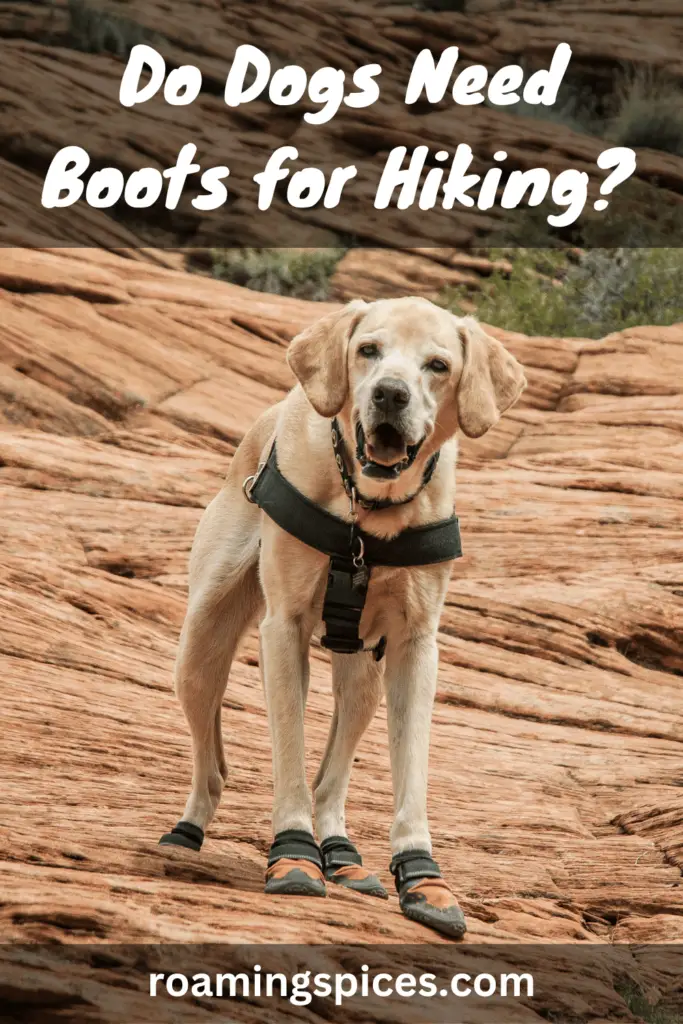
Hiking with Dogs
Do Dogs Need Boots for Hiking?” is a question that often perplexes dog owners venturing into the great outdoors with their furry companions. As we delve into the considerations surrounding this query, we’ll explore the benefits, alternatives, and crucial factors to ensure your canine companion’s comfort and safety on the hiking trail
Hiking Boots for Dogs
Exploring the great outdoors with your furry companion is a rewarding experience that strengthens the bond between humans and dogs. As you embark on a variety of hiking trails, you may have pondered a vital question: do dogs need boots for hiking?
This seemingly straightforward query delves deep into the realms of canine comfort, safety, and well-being amidst the challenges presented by Mother Nature.
In this article, we embark on a journey to uncover the truth behind the necessity of hiking boots for dogs. We’ll explore the intricate anatomy of canine paws, the potential benefits of these specialised boots, and the essential considerations to remember before strapping them onto your four-legged adventurer.
Whether you’re a seasoned outdoor enthusiast or a first-time hiker with your canine companion, the insights you’ll gain here will help you make an informed decision, ensuring your dog’s paws are well-prepared for the trails.
Join us in this exploration of the fascinating world where the needs of our loyal hiking partners meet the great outdoors.
The Canine Paw Anatomy
Understanding Dog Paw Structure
The canine paw anatomy is a marvel of evolutionary adaptation, serving as the foundation for a dog’s mobility and protection. Dog owners and enthusiasts need to understand dog paw structure and its natural protection mechanisms.
A dog’s paw consists of several vital components. The most visible part is the paw pad, a thick, cushioned layer of skin and connective tissue. Paw pads vary in thickness among breeds, with some adapted for rugged terrains and others for smoother surfaces.
Paw pads serve as shock absorbers, helping dogs navigate different surfaces and terrain while providing insulation from extreme temperatures.
Beneath the paw pad lie the metacarpal and metatarsal bones, equivalent to the bones in a human hand and foot. These bones give the paw its shape and structure, allowing for flexibility and weight-bearing capacity. Surrounding the bones are ligaments, tendons, and muscles, all of which work together to strengthen and stabilise the paw.
Natural Protection Mechanisms
One remarkable aspect of canine paw anatomy is its natural protection mechanisms. The paw pad’s thick skin and fatty tissue are a barrier against sharp objects, hot surfaces, and cold temperatures.
The paw’s ability to sweat through sweat glands on the pads also helps regulate body temperature, and the presence of scent glands leaves a unique odour trail, marking a dog’s territory.
In conclusion, understanding the canine paw anatomy and its natural protection mechanisms is crucial for dog owners to ensure their pet’s comfort, safety, and overall well-being. Dogs rely on their paws for daily activities, making it essential to provide proper care and attention to this remarkable part of their anatomy.
The Benefits of Dog Hiking Boots
Dog hiking boots are not just a fashion statement; they offer several practical benefits for both dogs and their owners when embarking on outdoor adventures. Here are some key advantages.
1. Protection from Rough Terrain
Dog hiking boots provide a protective layer between your furry companion’s paws and rough, uneven terrain. Sharp rocks, thorns, and abrasive surfaces can cause painful cuts, scratches, or abrasions. Boots are a barrier, preventing injuries and discomfort during hikes, trail runs, or outdoor activities.
2. Weatherproofing & Temperature Control
Hiking boots for dogs often come with weatherproof features, including waterproof materials and insulation. This helps keep your dog’s paws dry and warm in wet or cold conditions, ensuring their comfort during inclement weather.
Dog boots are designed to regulate temperature, providing insulation in cold weather and breathability in hot conditions. This temperature control helps prevent frostbite or overheating, ensuring your dog can comfortably endure various climates.
3. Injury Prevention
Dogs can be prone to injuries during outdoor activities. Hiking boots offer stability and support, reducing the risk of sprained ankles or strained ligaments. They also provide traction on slippery surfaces, preventing slips and falls.
In conclusion, dog hiking boots offer practical advantages that extend beyond aesthetics. They safeguard your dog’s paws from potential hazards, maintain their comfort in various weather conditions, and contribute to injury prevention.
When selecting hiking boots for your canine companion, consider factors such as fit, durability, and the type of terrain you’ll encounter, ensuring a safe and enjoyable outdoor experience for you and your dog.
Considerations Before Booting Up Your Dog
Before strapping hiking boots onto your canine companion’s paws, it’s crucial to consider several factors to ensure their comfort, safety, and enjoyment on the trail.
Dog Breed and Size
Different dog breeds have varying paw sizes and shapes. Consider boots that are specifically designed for your dog’s breed or size. Smaller breeds may require lighter and more flexible boots, while larger breeds might need sturdier, more durable options. Additionally, some breeds may have a higher tolerance for rough terrains, affecting the boot choice.
Terrain and Weather Conditions
The type of terrain and weather you’ll encounter on your hike plays a significant role in selecting the right boots. For rocky or abrasive terrains, opt for boots with durable soles that provide protection against sharp objects. Waterproof and insulated boots are essential in wet or cold conditions to keep your dog’s paws dry and warm. Conversely, in hot weather, choose breathable boots to prevent overheating.
Comfort and Fit
Proper fit is crucial to ensure your dog’s comfort and mobility. Ill-fitting boots can cause chafing, discomfort, and even injuries. Measure your dog’s paws accurately, following the manufacturer’s guidelines, and observe sizing charts.
Boots should fit snugly without being too tight, with room for the toes to move naturally. Check for any signs of discomfort, such as rubbing or limping, during the first few uses and make adjustments as needed.
Training and Familiarisation
Introducing your dog to hiking boots requires patience and positive reinforcement. Dogs may initially resist wearing boots, so gradually introduce them indoors to allow your dog to get used to the sensation.
Use treats and praise to create a positive association with the boots. Gradually increase the duration your dog wears the boots until they are comfortable wearing them for extended periods.
In conclusion, before outfitting your dog with hiking boots, consider their breed and size, the terrain and weather conditions you’ll encounter, the comfort and fit of the boots, and the training and familiarisation process.
Properly chosen and fitted boots can enhance your dog’s outdoor experience, providing protection, comfort, and injury prevention on your hiking adventures.
Alternatives to Dog Hiking Boots
While dog hiking boots are beneficial for protecting your furry friend’s paws during outdoor adventures, there are alternative options to consider, each catering to specific needs and preferences.
Natural Paw Conditioners
Paw Wax is a natural alternative that provides a protective layer to your dog’s paw pads. It helps guard against rough terrain, hot surfaces, and snow. Simply apply the wax and let it dry before heading out. It’s beneficial for dogs who dislike wearing boots. Be mindful of the ingredients to ensure they are safe for your dog.
Balm or Salve are moisturisers that help keep your dog’s paw pads soft and resilient. They can offer protection against minor cuts and abrasions. Look for products with natural ingredients like shea butter, coconut oil, or beeswax.
Dog Socks and Paw Protectors
Dog Socks provide traction and some protection against harsh surfaces. They are suitable for indoor use or on warmer days when minimal protection is needed. Some socks come with anti-slip grips on the underside, preventing slipping on smooth floors.
Paw Protectors are lightweight, flexible coverings providing protection against hot pavements, salted roads, or abrasive surfaces. They are a great alternative to boots in milder conditions. Look for options made from breathable and non-toxic materials.
Disposable Booties are thin, single-use covers that slip over your dog’s paws. They are handy for short-term use in situations like preventing muddy paw prints indoors or providing temporary protection during specific outdoor activities.
Consider your dog’s comfort, the specific terrain and weather conditions, and tolerance when choosing an alternative to hiking boots. Remember that while these alternatives offer some protection, hiking boots in rugged or extreme conditions may be more robust.
Always monitor your dog for any signs of discomfort or irritation when using these alternatives, and adjust accordingly to ensure a safe and enjoyable experience for your furry companion.
How to Properly Fit and Maintain Dog Hiking Boots
Ensuring your dog’s hiking boots fit correctly and are well-maintained is crucial for their comfort and safety during outdoor adventures. Here’s a guide on properly fitting and maintaining dog hiking boots.
Measuring Your Dog’s Paws
Before purchasing boots, accurately measure your dog’s paws. Use a soft measuring tape to measure the width and length of each paw. Pay attention to the manufacturer’s sizing guidelines, as different brands may have slightly different sizing charts. If your dog’s paws are between sizes, opt for the larger size for a more comfortable fit.
Putting on and Adjusting Boots
Start Indoors: Introduce your dog to the boots indoors to reduce anxiety. Allow them to sniff and inspect the boots before putting them on.
Proper Fit: Ensure the boots are snug but not too tight. They should stay securely on your dog’s paws without causing discomfort or restricting movement. Check that the boots are tight enough, which can lead to chafing or slipping.
Secure Closures: Most dog boots have Velcro straps or buckles to secure them in place. Ensure these closures are fastened snugly but not too tight, which can cause discomfort.
Cleaning and Maintenance Tips
Inspect Regularly: Before each hike, inspect the boots for signs of wear and tear. Look for loose stitching, damaged soles, or any signs of damage. Replacing damaged boots promptly is essential.
Clean After Use: After each hike, remove and clean the boots. Use a mild detergent and warm water to remove dirt and debris. Rinse thoroughly and allow them to air dry completely.
Inspect Paws: Check your dog’s paws for any signs of irritation or discomfort after using the boots. Look for redness, chafing, or blisters. Adjust the fit if necessary.
Storage: Store the boots in a cool, dry place away from direct sunlight. This helps prolong their lifespan.
Properly fitting and maintaining your dog’s hiking boots provides protection and comfort during outdoor adventures. Regularly inspecting and cleaning the boots and monitoring your dog’s comfort will help keep your furry friend safe and happy on the trail.
Do Dogs Need Boots for Hiking? Conclusion
In conclusion, whether dogs need boots for hiking depends on several factors, including the individual dog, the terrain, and the weather conditions. While hiking boots can provide essential protection against rough terrain, extreme temperatures, and potential hazards, they may not be necessary for every dog or every hiking trip.
Dog owners need to consider their canine companions’ specific needs and preferences. Some dogs may adapt well to boots and benefit significantly from the added protection, while others may find them uncomfortable or unnecessary.
Ultimately, the decision to use hiking boots for your dog should be guided by a careful assessment of the terrain and weather, the dog’s breed and size, and comfort level with the boots. Alternatives like natural paw conditioners, dog socks, or paw protectors can also provide varying degrees of protection and may be more suitable in certain situations.
The well-being and comfort of your dog should always be the top priority when hiking together. Whether you choose to use boots or not, regularly monitoring your dog’s paws, proper training, and adjustments to their gear as needed will ensure that your hiking adventures remain enjoyable and safe for you and your furry friend.
Like Our Article? Please Pin it!



Leave a Reply